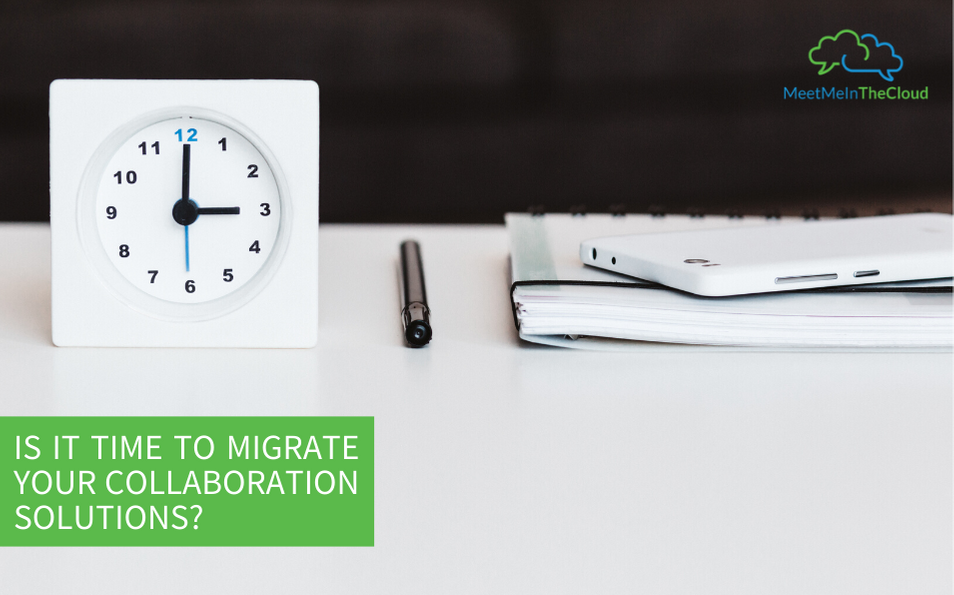When it comes to your workforce’s collaboration efforts, you likely rely on in-person collaboration and legacy solutions that require bulky hardware or frequent software installations. But with work-from-home (WFH) initiatives and team members on the go, it may be time to migrate to a better collaboration solution that meets your business’s needs.
What is Migration?
Before we discuss the reasons for migrating, it’s important to understand what migration is. Migration is the act of upgrading to new hardware, new software, or both. This process involves moving data and capabilities from the legacy solution to the new solution. While this process seems simple, it’s not. Migrations are often complicated and intricate endeavors that are time-consuming for your team if you choose to implement them in-house.
The migration process ensures that the new operating environment is functional, secure, and usable by your team. This involves a review of your legacy application and its settings as well as setting up the new solution.
Types of Migrations
There are many different types of technology migrations, including:
- Database and data migration
- Application migration
- Cloud migration
- Enterprise Resource Planning (ERP) software migration
- Operating System (OS) migration
- Content Management System (CMS) migration
- IT infrastructure migration
At Meet Me In The Cloud, we specialize in collaboration solutions migration, which is typically an application or cloud migration, depending on what solution you choose.
Reasons for Migration
If migrations are typically challenging, then why do companies do it? Why don’t they continue to use their legacy collaboration solutions indefinitely? Here’s why companies migrate to better solutions:
The Legacy Solution is Deprecated or Obsolete
If your workforce is using an outdated collaboration solution, it may be deprecated or obsolete. If it’s “deprecated,” that means it’s still a good solution for now, but it won’t be for long. That solution will likely be obsolete when a new solution is launched. If a solution is “obsolete,” then your workforce can no longer use it.
For solutions that are either deprecated or obsolete, there is little or no support from the vendor, which means if something goes wrong, it may never get fixed. This can lead to data loss and cybersecurity vulnerability.
The Legacy Solution Does Not Fulfill New Needs
Your business is flexible and adapts to the ever-changing market and the needs of your customers. You need a collaboration solution with modern capabilities that simplifies communication and work processes for your workforce.
If your business demands new capabilities from your collaboration solution and the vendor can’t keep up with your request, it may be time to migrate.
You Need to Consolidate
If your workforce is using multiple collaboration solutions, it creates a messy, inefficient process for everyone involved. Data can be siloed or lost and employees waste time connecting to multiple solutions.
To resolve these issues, you need to consolidate to one collaboration solution. You will likely need to migrate to a new one to do so because if your team is currently using multiple solutions, none of them are probably meeting all of your needs.
You Need Room to Grow
Your growing business needs room to grow, including in your collaboration solutions. Most legacy solutions limit users or storage space in some way and may incur additional costs when you do grow, if they can accommodate your growth.
Most modern collaboration solutions are now hosted in the cloud, which provides you with scalability and flexibility, accommodating to your ever-changing needs.
Your Workforce Uses Multiple Devices
If your employees WFH or work on the go, they likely use multiple devices to complete tasks and collaborate with their teams. Legacy collaboration solutions are limited to specific devices, but solutions in the cloud can be accessed anywhere from any device, enabling your workforce to work on the go in real-time.
You Need Increased Security
Security is likely one of your top concerns, but your legacy collaboration solutions may not meet your security standards. Most legacy solutions that were rolled out within the past decade or earlier weren’t created with the same security measures we have today. Cyber threats are constantly evolving and new technologies are accomodating to those changes to protect your data. Your legacy solution probably isn’t adapting as fast, if at all.
Is It Time to Migrate?
If you can identify with one or more of the reasons above, then it’s time to migrate to a new collaboration solution. Don’t go through that process alone. Learn more about our Migration Services at this link.

